accident

 My grandnephew, Matt Masterson is very quickly becoming a man. Recently, Matt has been looking for a job. Matt likes to be a help to his family, and since he is the only one of the kids that drive, he is really good about taking his sisters, Raelynn and Taylor wherever they need to go. He offers to take them to get food, drinks, or anything else they want to do. He really enjoys having them in the car with him, unless he has a lot on his mind.
My grandnephew, Matt Masterson is very quickly becoming a man. Recently, Matt has been looking for a job. Matt likes to be a help to his family, and since he is the only one of the kids that drive, he is really good about taking his sisters, Raelynn and Taylor wherever they need to go. He offers to take them to get food, drinks, or anything else they want to do. He really enjoys having them in the car with him, unless he has a lot on his mind.
Unfortunately, with driving comes the possibility of accidents, and while Matt has not had an accident that was his fault, he has been in two accidents, and on the 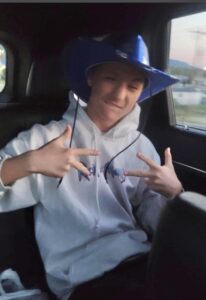
 last one, Raelynn was with him. Matt is so supportive of his sisters. After calling his parents and the cops, Matt came back to make sure Raelynn had her water and helped her through the panic attack she was having. No one was hurt in the accident, but Raelynn was still scared. Matt just took control. He had her sit down, and talked her through it, making sure that she stayed focused of the positive side of things. Matt is such a great brother to his sisters. They depend on him for many things, and Raelynn says that she can tell that he is going to be an “awesome dad one day too, when he decides he wants kids.”
last one, Raelynn was with him. Matt is so supportive of his sisters. After calling his parents and the cops, Matt came back to make sure Raelynn had her water and helped her through the panic attack she was having. No one was hurt in the accident, but Raelynn was still scared. Matt just took control. He had her sit down, and talked her through it, making sure that she stayed focused of the positive side of things. Matt is such a great brother to his sisters. They depend on him for many things, and Raelynn says that she can tell that he is going to be an “awesome dad one day too, when he decides he wants kids.”
For now, that is down the road a little bit, since Matt is only 17 years old. For now, Matt has been looking for a job! He really wants to be able to help out. Not many 17-year-old kids are interested in being a contributor to 
 the family finances, so that is cool. Even things like buying his own clothes and other supplies can be helpful. Clothes are expensive. Matt is looking forward in life, planning his future. He may not know exactly where he is going right now, but he focused on making good decisions and staying on the right track. Even though it’s summer, Matt’s been sleeping in less and making an effort to be nice to people and get out and do things more! That’s a big job in this Post-Covid-Lockdown world. Today is Matt’s 17th birthday. Happy birthday Matt!! Have a great day!! We love you!!
the family finances, so that is cool. Even things like buying his own clothes and other supplies can be helpful. Clothes are expensive. Matt is looking forward in life, planning his future. He may not know exactly where he is going right now, but he focused on making good decisions and staying on the right track. Even though it’s summer, Matt’s been sleeping in less and making an effort to be nice to people and get out and do things more! That’s a big job in this Post-Covid-Lockdown world. Today is Matt’s 17th birthday. Happy birthday Matt!! Have a great day!! We love you!!
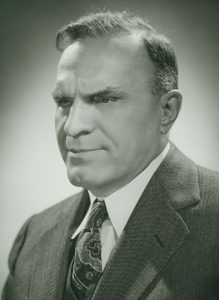 They say that “necessity is the mother of invention,” and never was that more true than for Ralph Teetor. The circumstances of his invention were of overwhelming necessity…to say the least. Teetor was blind, and because of that, he was forced to accept rides to wherever he chose to go. His friend, Harry Lindsay, who didn’t mind driving Teetor around, but who also had a notoriously “jerky accelerator foot.” Teetor couldn’t figure out why, Lindsay couldn’t keep the car at a consistent speed. When you think about it, a car that is being driven in a jerky manner would be a bit scary for a blind passenger, who has no idea why they might be possible stopping suddenly… or even if it just seems like they are stopping suddenly.
They say that “necessity is the mother of invention,” and never was that more true than for Ralph Teetor. The circumstances of his invention were of overwhelming necessity…to say the least. Teetor was blind, and because of that, he was forced to accept rides to wherever he chose to go. His friend, Harry Lindsay, who didn’t mind driving Teetor around, but who also had a notoriously “jerky accelerator foot.” Teetor couldn’t figure out why, Lindsay couldn’t keep the car at a consistent speed. When you think about it, a car that is being driven in a jerky manner would be a bit scary for a blind passenger, who has no idea why they might be possible stopping suddenly… or even if it just seems like they are stopping suddenly.
For Teetor, the possibility of things changing was impossible. He was not going to magically get his sight back, so something else had to change. Teetor was no stranger to the idea of inventing things. At the age of five, he endured a terrible accident, which 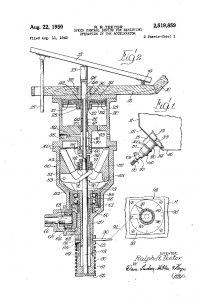 left him in his disabled condition. He was incredibly young age, but Teetor refused to allow an accident to keep him from living a full life. At age 12, he was featured in the December 21, 1902 edition of the New York Herald for building a one-cylinder car to scoot around in his neighborhood. Here is how the Herald described him in 1902: “A constructor of miniature dynamos and other machinery at 10 and thoroughly versed in all that pertains to their operation, and at 12 the builder of an automobile that carries him about the streets of his native town and far out upon the country roads at a speed of from 18 to 25 miles an hour, is the remarkable record of Ralph Teetor of Hagerstown, Indiana.”
left him in his disabled condition. He was incredibly young age, but Teetor refused to allow an accident to keep him from living a full life. At age 12, he was featured in the December 21, 1902 edition of the New York Herald for building a one-cylinder car to scoot around in his neighborhood. Here is how the Herald described him in 1902: “A constructor of miniature dynamos and other machinery at 10 and thoroughly versed in all that pertains to their operation, and at 12 the builder of an automobile that carries him about the streets of his native town and far out upon the country roads at a speed of from 18 to 25 miles an hour, is the remarkable record of Ralph Teetor of Hagerstown, Indiana.”
Teetor set out to solve his problem. He invented what we know today as the automobile cruise control system, which is an outer control loop that “takes over” control of the throttle…a task normally exercised by the driver through the accelerator pedal. Unlike the driver of the vehicle, the cruise control holds the vehicle speed steady at a set value. The invention worked perfectly on the first try, but being a perfectionist, Teetor spent the next decade tinkering with his design. By 1958, he had finally perfected his invention. Nevertheless, Cadillac began 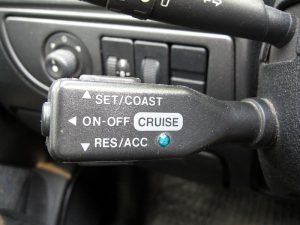 rolling it out in all of their cars by 1950. The only part of his invention that Teetor ever struggled with was the name. At first, the invention was known by “a host of names more suited for the Wiley Coyote: Speedostat, Touchomatic, and Auto-pilot.” Eventually, the designers at Chrysler came up with “cruise control.” It wasn’t flashy, but it was also less likely to be mistaken for “a kitchen appliance.” Teetor decided that sacrifices just had to be made sometimes. So now you know that the cruise control…the gas-conserving savior of long-distance drivers everywhere, actually came from one man’s pet peeve. I would imagine that if you were blind, and being thrown around in your seat because you couldn’t drive yourself, you might be pretty grouchy, too.
rolling it out in all of their cars by 1950. The only part of his invention that Teetor ever struggled with was the name. At first, the invention was known by “a host of names more suited for the Wiley Coyote: Speedostat, Touchomatic, and Auto-pilot.” Eventually, the designers at Chrysler came up with “cruise control.” It wasn’t flashy, but it was also less likely to be mistaken for “a kitchen appliance.” Teetor decided that sacrifices just had to be made sometimes. So now you know that the cruise control…the gas-conserving savior of long-distance drivers everywhere, actually came from one man’s pet peeve. I would imagine that if you were blind, and being thrown around in your seat because you couldn’t drive yourself, you might be pretty grouchy, too.
 I think most people have played with a Slinky at one point or another in their lives. The Slinky is a pre-compressed helical spring toy invented by Richard James in the early 1940s. It is able to perform a number of tricks, including travelling down a flight of steps end-over-end as it stretches and re-forms itself with the aid of gravity and its own momentum, or appear to levitate for a period of time after it has been dropped. Kids have been known to spend hours playing with the simple spring, which rather defies the imagination in itself. Most kids tire easily of toys, so the long lasting play with a slinky was surprising. Still, as with all such toys, the Slinky eventually lost its draw, and few people play with it now.
I think most people have played with a Slinky at one point or another in their lives. The Slinky is a pre-compressed helical spring toy invented by Richard James in the early 1940s. It is able to perform a number of tricks, including travelling down a flight of steps end-over-end as it stretches and re-forms itself with the aid of gravity and its own momentum, or appear to levitate for a period of time after it has been dropped. Kids have been known to spend hours playing with the simple spring, which rather defies the imagination in itself. Most kids tire easily of toys, so the long lasting play with a slinky was surprising. Still, as with all such toys, the Slinky eventually lost its draw, and few people play with it now.
The strangest thing about the Slinky is that it wasn’t invented to be a toy at all. In 1943, a naval mechanical 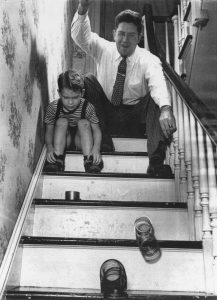 engineer named Richard James, who was stationed at the William Cramp and Sons shipyards in Philadelphia, was developing springs that could support and stabilize sensitive instruments aboard ships in rough seas. As he worked, James accidentally knocked one of the springs from a shelf, and watched as the spring “stepped” in a series of arcs to a stack of books, to a tabletop, and to the floor, where it re-coiled itself and stood upright. I’m sure the sight was funny, mostly because it was so unexpected. As his wife Betty later recalled, “He came home and said, ‘I think if I got the right property of steel and the right tension; I could make it walk.'” As with any inventor, I’m sure that his inventor’s mind was already clicking. James began to experiment with different types of steel wire over the next year, and finally found a spring that would walk. I’m sure he was like “a kid in a candy store” with each fine-tuning of the toy. Betty was skeptical at first, but changed her mind after the toy was fine-tuned and neighborhood children expressed an excited interest in it. She dubbed the toy Slinky, by which she meant “sleek and graceful,” after finding the word in a dictionary, Betty decided that this word exactly described the sound of a metal spring expanding and collapsing.
engineer named Richard James, who was stationed at the William Cramp and Sons shipyards in Philadelphia, was developing springs that could support and stabilize sensitive instruments aboard ships in rough seas. As he worked, James accidentally knocked one of the springs from a shelf, and watched as the spring “stepped” in a series of arcs to a stack of books, to a tabletop, and to the floor, where it re-coiled itself and stood upright. I’m sure the sight was funny, mostly because it was so unexpected. As his wife Betty later recalled, “He came home and said, ‘I think if I got the right property of steel and the right tension; I could make it walk.'” As with any inventor, I’m sure that his inventor’s mind was already clicking. James began to experiment with different types of steel wire over the next year, and finally found a spring that would walk. I’m sure he was like “a kid in a candy store” with each fine-tuning of the toy. Betty was skeptical at first, but changed her mind after the toy was fine-tuned and neighborhood children expressed an excited interest in it. She dubbed the toy Slinky, by which she meant “sleek and graceful,” after finding the word in a dictionary, Betty decided that this word exactly described the sound of a metal spring expanding and collapsing.
 The couple formed James Spring and Wire Company, which was later renamed James Industries, using just a $500 loan. They had 400 Slinky units made by a local machine shop, hand-wrapped each in yellow paper, and priced them at $1 a piece. Each was 2½ inches tall, and included 98 coils of high-grade blue-black Swedish steel. At first, the James couple had difficulty selling Slinky to toy stores but, then in November 1945, they were granted permission to set up an inclined plane in the toy section of Gimbels department store in Philadelphia to demonstrate the toy. Finally, the Slinky was a hit, and the first 400 units were sold within ninety minutes. In 1946, Slinky was introduced at the American Toy Fair. The Slinky was without doubt a huge success, yet in it’s humble beginnings, it was an accident.
The couple formed James Spring and Wire Company, which was later renamed James Industries, using just a $500 loan. They had 400 Slinky units made by a local machine shop, hand-wrapped each in yellow paper, and priced them at $1 a piece. Each was 2½ inches tall, and included 98 coils of high-grade blue-black Swedish steel. At first, the James couple had difficulty selling Slinky to toy stores but, then in November 1945, they were granted permission to set up an inclined plane in the toy section of Gimbels department store in Philadelphia to demonstrate the toy. Finally, the Slinky was a hit, and the first 400 units were sold within ninety minutes. In 1946, Slinky was introduced at the American Toy Fair. The Slinky was without doubt a huge success, yet in it’s humble beginnings, it was an accident.
 My nephew, Rob Masterson has been working at Sam’s Club in the Tire and Battery Center since August 1, 2017. Rob had not been able to work for some time, due to health issues brought on by his time in the service. The VA really wasn’t helpful to him, and after 4 plus years of waiting for them to decide on disability status, he’d had enough. Rob and his wife, Dustie were both unhappy with their current situation. Her job was not fulfilling, and they took her for granted. Then, Rob and Dustie basically stumbled on their jobs, and they will tell you that it was the best kind of accident to have. They were shopping at Sam’s club when they saw that Sam’s was hiring. They filled out the online application, and first Rob was called, and then Dustie. They were so excited to find that they would both be working at the same place. As Dustie puts it, “It’s amazing being able to work with your best friend. You know all the same people at work for the most part, and even though most people might find it weird to be able to discuss work and both know exactly what the other does, for us it’s just natural.” They did their orientation together, and both started on August 1, 2017. Rob actually started working before he completed the orientation, because his boss came in and said, “I need you now!” He would have to complete his orientation later. Rob, who has Rheumatoid Arthritis, was a little nervous about how his knees were going to handle the work, but he says that it hasn’t been too bad. Rob and Dustie prayed about his knees and ask for strength to be able to handle the work, and God answered their prayers.
My nephew, Rob Masterson has been working at Sam’s Club in the Tire and Battery Center since August 1, 2017. Rob had not been able to work for some time, due to health issues brought on by his time in the service. The VA really wasn’t helpful to him, and after 4 plus years of waiting for them to decide on disability status, he’d had enough. Rob and his wife, Dustie were both unhappy with their current situation. Her job was not fulfilling, and they took her for granted. Then, Rob and Dustie basically stumbled on their jobs, and they will tell you that it was the best kind of accident to have. They were shopping at Sam’s club when they saw that Sam’s was hiring. They filled out the online application, and first Rob was called, and then Dustie. They were so excited to find that they would both be working at the same place. As Dustie puts it, “It’s amazing being able to work with your best friend. You know all the same people at work for the most part, and even though most people might find it weird to be able to discuss work and both know exactly what the other does, for us it’s just natural.” They did their orientation together, and both started on August 1, 2017. Rob actually started working before he completed the orientation, because his boss came in and said, “I need you now!” He would have to complete his orientation later. Rob, who has Rheumatoid Arthritis, was a little nervous about how his knees were going to handle the work, but he says that it hasn’t been too bad. Rob and Dustie prayed about his knees and ask for strength to be able to handle the work, and God answered their prayers.
He applied for one transfer within the store, but didn’t get it and Dustie says, “I’m glad. When the position opened up to be the team lead over Tire Battery Center, I knew it was a perfect one for him.” I think they didn’t give him the first position, because they knew he was a great asset to the Tire and Battery Center, and they didn’t want to lose him. In the short time that Rob has worked at Sam’s, he has proven his worth. Dustie says that Rob is so nervous about being a supervisor again, but what he doesn’t realize that he is doing a great job. The people that he works with and the people that work for him have nothing but respect for him, and vice 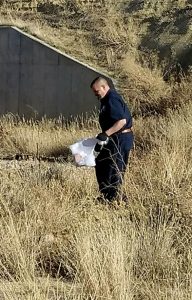 versa. He treats everyone equally and with respect. You can see that he is so much happier…though more tired now, but she doesn’t think he will give it up…ever. He takes pride in his work and it shows. From sweeping the floor and taking out the trash to making sure the tires are correct in size and mounted properly. I think that Rob has always loved tinkering on cars, and so this was right up his alley.
versa. He treats everyone equally and with respect. You can see that he is so much happier…though more tired now, but she doesn’t think he will give it up…ever. He takes pride in his work and it shows. From sweeping the floor and taking out the trash to making sure the tires are correct in size and mounted properly. I think that Rob has always loved tinkering on cars, and so this was right up his alley.
Rob even has his special clients…the ones who ask for him, and who don’t want anyone else to work on their vehicle. One of them is a cute older woman who will not allow anyone else to work on her car, but Rob. Apparently her husband just recently passed away and he was the one who took care of everything on the car for her. When Rob helped her with her car, she was so relieved that someone truly cared, that she teared up. Dustie says, “I couldn’t be more proud of my husband. He is such a wonderful man and he’s making a lasting impression on this Earth and in Heaven. I couldn’t agree more. Today is Rob’s birthday. Happy birthday Rob!! Have a great day!! We love you!!

 It’s hard for me, and even harder for his mom, my niece Machelle Moore to believe that her son, my grand nephew, Weston Moore is eighteen today. Weston is a busy guy these days. He likes to participate in several sports, including football and track and is pretty good in both. Weston is a tall, broad shouldered young man, and that makes him tough to go through on the football field. In track, he is participating in shot put and discus, where his strong shoulders are an asset.
It’s hard for me, and even harder for his mom, my niece Machelle Moore to believe that her son, my grand nephew, Weston Moore is eighteen today. Weston is a busy guy these days. He likes to participate in several sports, including football and track and is pretty good in both. Weston is a tall, broad shouldered young man, and that makes him tough to go through on the football field. In track, he is participating in shot put and discus, where his strong shoulders are an asset.
Weston got a job bagging groceries at Blair’s in Powell, so now he has gas money for school and all the activities he is involved in…and any social events, of course. Weston gets himself up most days to go to “0” hour and leaves the house at 6:30am. I guess that if you are dedicated to what you are doing, you do what you have to do to make it happen. Weston has proven that he has what it takes to make his dreams come true. Weston has plans to work lots of hours this summer so he can save p money for a new vehicle.
You see, while this has been a pretty good year for Weston, his car has not fared so well. Being parked in the high school parking lot, has taken a toll on his car. It has been hit a few times…after he hit a parked truck that is. His parents, Steve and Machelle went over to the accident scene, and Weston’s glasses were half way out the window. They got knocked off when he looked out the window while he hit the truck. It was not one of Weston’s better days. Steve had to tie up his front bumper with zip ties so that it didn’t fall all the way off. While the bumper looks better than it did, it now remains a constant reminder of the accident. I guess that if 
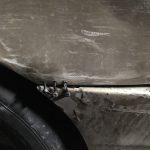 that is the worst that ever comes of Weston’s early driving experience, then he is doing pretty good. Most kids have an accident in the first few years of driving, so we can all just be thankful that the damage wasn’t worse and no one was hurt. All in all, I’m sure that Weston must be a pretty good driver, because he’s only had one accident in two years of driving. As an insurance agent, I can tell you that I have seen much worse from drivers, and some of them have far more experience than Weston has. Today is Weston’s 18th birthday. Happy birthday Weston!! Have a great day!! We love you!!
that is the worst that ever comes of Weston’s early driving experience, then he is doing pretty good. Most kids have an accident in the first few years of driving, so we can all just be thankful that the damage wasn’t worse and no one was hurt. All in all, I’m sure that Weston must be a pretty good driver, because he’s only had one accident in two years of driving. As an insurance agent, I can tell you that I have seen much worse from drivers, and some of them have far more experience than Weston has. Today is Weston’s 18th birthday. Happy birthday Weston!! Have a great day!! We love you!!
 When someone becomes a police officer, they begin a career of service to their community. They run in when others are running out. They face the guns pointed at them, instead of hiding under a desk, like many of us would do. Still, all that does not really determine what kind of a police officer they will become. When my brother-in-law, Chris Hadlock, and my sister, Allyn were living in Fort Morgan, Colorado, Chris was in sales, but he knew that that was not what he wanted to do with his life. He told Allyn that he just didn’t want to do sales anymore. It wasn’t rewarding. He said that he didn’t think he could be a doctor, but he wanted to help people…he wanted to be a police officer. After the initial shock, and yes to a degree fear, wore off, Allyn agreed that it was what he needed to do. So began a long and rewarding career in law enforcement.
When someone becomes a police officer, they begin a career of service to their community. They run in when others are running out. They face the guns pointed at them, instead of hiding under a desk, like many of us would do. Still, all that does not really determine what kind of a police officer they will become. When my brother-in-law, Chris Hadlock, and my sister, Allyn were living in Fort Morgan, Colorado, Chris was in sales, but he knew that that was not what he wanted to do with his life. He told Allyn that he just didn’t want to do sales anymore. It wasn’t rewarding. He said that he didn’t think he could be a doctor, but he wanted to help people…he wanted to be a police officer. After the initial shock, and yes to a degree fear, wore off, Allyn agreed that it was what he needed to do. So began a long and rewarding career in law enforcement.
Chris became a deputy sheriff in 1990, when he joined the Natrona County Sheriff’s Department. After a time, he had the opportunity to join the Casper Police Department, and in 1997, he became a patrolman with the CPD. Chris loved his career. He was in his element and he was very good at what he did. I had the opportunity on several occasions, to ride along with him, and I watched as he was able to quickly de-escalate a situation, and in the end, the person he was arresting was not only cooperative, but in some cases, thanked him for making the arrest as painless as possible. Now, as we all know, not every situation works out that well, but those that did were truly amazing. Over the years, Chris has 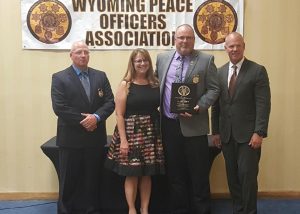 tested for and been promoted to Sergeant and then, Lieutenant, which is the rank he currently holds. He has been a hiring and training officer, shift supervisor, and is currently over Investigations, Victim Services, Operations Support Team, and Property Evidence.
tested for and been promoted to Sergeant and then, Lieutenant, which is the rank he currently holds. He has been a hiring and training officer, shift supervisor, and is currently over Investigations, Victim Services, Operations Support Team, and Property Evidence.
Last night, the culmination of all his years of service, was recognized by the Wyoming Peace Officers Association at their annual banquet, held in Cheyenne, Wyoming. We, his family are so proud to announce that Chris Hadlock was awarded the Wyoming Peace Officer of the Year award. To receive this award, the candidate must be nominated. Chris was the nominee for the Casper Police Department, and based on his long standing law enforcement career and his continual service to the public, first as a deputy and then as a police officer, Chris won the award. He and Allyn had their picture taken with the Governor of Wyoming, Matt Meade, and the president of the Wyoming Peace Officers Association, Tom Stoker. Chris also received an engraved plaque, and will be receiving an engraved revolver. Then, in May, he and Allyn will travel to Washington DC for National Police Week. They will attend the National Peace Officers Memorial Service which commemorates fallen officers.
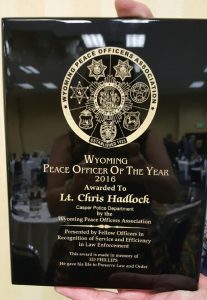
Chris says that this is such an honor, and he feels very humbled by it. We can’t think of anyone who could possibly deserve it more. Once the decision was made to become a police officer, Chris never looked back. It was his dream career and he would never think of doing anything else. For him, it isn’t just a career. It goes back to that original desire, “I want to help people.” A police officer has parts of his job that are necessary, but not really fun, such as issuing citations, but when you are the first on the scene at an accident, and someone is in serious need, and you save a life…it just doesn’t get better than that. When you are instrumental in getting people out of a dangerous situation, and lives are saved…that’s what it’s all about. That is what Chris meant when he said he wanted to help people, and that is what he has done. Congratulations to Lieutenant Christopher Hadlock, Wyoming’s Peace Officer of the Year!! We are so very proud of you!! Thank you for your years of service!!
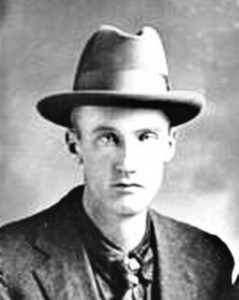 My husband, Bob’s great grandfather, Chester Leary worked for the railroad for most of his adult life. As a railroad worker, I’m sure he saw his share of close calls and accidents over the many years he worked there. Many railroad accidents make the national news, of course, but it’s possible they didn’t so often many years ago, because communication wasn’t quite as good. Nevertheless, if you lived near the train wreck, I’m sure you heard about it. I’m also sure that railroad yard accidents were a somewhat common occurrence. There is so much that goes on in a railroad yard, that sometimes things get missed, and an accident happens, but in my research for this story, I couldn’t find the accident in question here, or in fact, much information about very many railroad yard accidents at all. Maybe they just weren’t a news worthy event, unless someone was killed in the accident.
My husband, Bob’s great grandfather, Chester Leary worked for the railroad for most of his adult life. As a railroad worker, I’m sure he saw his share of close calls and accidents over the many years he worked there. Many railroad accidents make the national news, of course, but it’s possible they didn’t so often many years ago, because communication wasn’t quite as good. Nevertheless, if you lived near the train wreck, I’m sure you heard about it. I’m also sure that railroad yard accidents were a somewhat common occurrence. There is so much that goes on in a railroad yard, that sometimes things get missed, and an accident happens, but in my research for this story, I couldn’t find the accident in question here, or in fact, much information about very many railroad yard accidents at all. Maybe they just weren’t a news worthy event, unless someone was killed in the accident.
In fact, I wouldn’t have known about this train wreck at all, except that Bob’s cousin, Joe Brown sent me the picture of the wreck, with Chester Leary in the picture. The picture had the date of the accident listed on the picture, so I know that the date is correct…May 2, 1919. Nevertheless, when I looked for information on that train wreck in Forsyth, Montana in the railroad yard, I found absolutely nothing. To me that is such an odd thing. My curious mind wants to know more about how this accident happened. Was someone not paying attention to the trains coming in and out of the yard? Was anyone hurt? When did electronic tracking of the trains come into being, and would that have made a difference, since it all happened in the yard?
![Train Wreck at Forsyth, MT]pm yard May 2, 1919 Chester Leary](https://carynschulenberg.com/wp-content/uploads/2016/01/Train-Wreck-at-Forsyth-MT-yard-May-2-1919-Chester-Leary-300x198.jpg) Unfortunately, Bob’s great grandfather is no longer with us, and in fact he passed away in 1950, before either of us were born, so we couldn’t have possibly asked such a question, and wouldn’t have know to had we been born earlier. I’m sure his grandmother, Vina Hein knew what happened, because she was probably told all about it by her dad, Chester Leary. I don’t know if her dad was involved, or not, but I’m sure that would have been a story told around the dinner table that night. I really wish I could have had the opportunity to ask Bob’s great grandfather or my grandfather about all of their railroad experiences, because I have to think that it would have been very interesting to hear about it all. Especially about when things went very wrong.
Unfortunately, Bob’s great grandfather is no longer with us, and in fact he passed away in 1950, before either of us were born, so we couldn’t have possibly asked such a question, and wouldn’t have know to had we been born earlier. I’m sure his grandmother, Vina Hein knew what happened, because she was probably told all about it by her dad, Chester Leary. I don’t know if her dad was involved, or not, but I’m sure that would have been a story told around the dinner table that night. I really wish I could have had the opportunity to ask Bob’s great grandfather or my grandfather about all of their railroad experiences, because I have to think that it would have been very interesting to hear about it all. Especially about when things went very wrong.
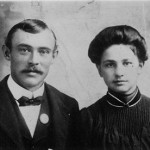
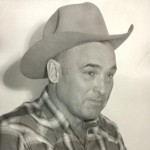 My curiosity about some of the family members on my husband, Bob’s side of our family, has led me to research the Forsyth, Montana area, because after all, that is where many of them lived for much of their lives. Some, including Julia (Doll) Schulenberg, and her husband, Max homesteaded here, until floods and droughts ruined their chances of making a living there. Then they moved into the little town of Forsyth, Montana, where they would live out their lives and raise their ten children, the oldest of whom was my husband, Bob’s grandfather, Andrew Schulenberg. Andy was the sheriff of Rosebud County from 1955 to 1972, in spite of the fact that he had lost his lower leg in a shooting accident when he was fifteen years old. To me that is rather an amazing feat for the times. Artificial legs of this day and age could probably facilitate an officer of the law’s need to run, but in those days, they did not have the technology to spring load the leg for running. During his term as sheriff, Andy became a much loved sheriff and citizen of the area, while also keeping the peace in the county.
My curiosity about some of the family members on my husband, Bob’s side of our family, has led me to research the Forsyth, Montana area, because after all, that is where many of them lived for much of their lives. Some, including Julia (Doll) Schulenberg, and her husband, Max homesteaded here, until floods and droughts ruined their chances of making a living there. Then they moved into the little town of Forsyth, Montana, where they would live out their lives and raise their ten children, the oldest of whom was my husband, Bob’s grandfather, Andrew Schulenberg. Andy was the sheriff of Rosebud County from 1955 to 1972, in spite of the fact that he had lost his lower leg in a shooting accident when he was fifteen years old. To me that is rather an amazing feat for the times. Artificial legs of this day and age could probably facilitate an officer of the law’s need to run, but in those days, they did not have the technology to spring load the leg for running. During his term as sheriff, Andy became a much loved sheriff and citizen of the area, while also keeping the peace in the county.
Before the town of Forsyth, Montana existed, the river steamers used to stop in the area to refuel their engines. The area had an abundance of cottonwood trees and that made it a perfect fuel location. To this day, Forsyth is known as the city of trees. The town sits along the Yellowstone River, and it got its name from General James W Forsyth, who stopped there on one of those river steamers, before there was even a town. The town would be established in 1880, and the post office would be established in 1882 when the Northern Pacific Railroad extended into the Judith Basin, which opened up the territory for settlement. It is located along 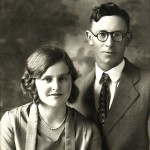
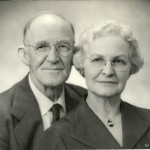 the Lewis and Clark Trail, which peaks my curiosity even more.
the Lewis and Clark Trail, which peaks my curiosity even more.
Max and Julia Schulenberg weren’t the only side of Bob’s family to settle in Forsyth. The Knox side of the family lived there too. Shortly after the death of their son, Joy Allen Knox, Bob’s maternal great grandparents, Edgar and Nellie (DeGood) Knox, moved from Prosser County, Washington to the Rosebud area to work on a ranch there. While Bob’s grandfather was not born in the area, he lived there until the early 1960s when they would move to Casper, Wyoming, which is where their daughter, Joann and her husband, Walter Schulenberg, who are Bob’s parents had moved. While Walt and Joann would never live in Montana again, Forsyth would remain an important part of their lives. Forsyth was, after all, an area where they had deep roots, connected to both sides of their family. With the move of the Knox family, the connection to Forsyth for that side of the family ended, however. Still the Schulenberg/Hein/Leary side of the family continues to have deep roots there to this day, and a number of the family members still live right there in Forsyth.
One of the things that I had always found very interesting about Forsyth is the cross on the hill. I always thought it was great that the town had decided to place the cross there, but now I find out that it was not the town at all. The cross, which has become a tourist attraction, as well as a source of inspiration and hope for the people of the area, was actually placed there early in the Fall of 1960 by the youth group of Concordia Lutheran Church. The idea was that of one of the youth group members, and was so well received by the entire 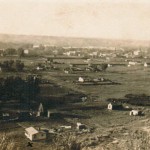
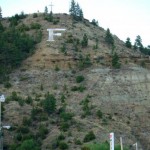 youth group, that they all gave up their Saturdays to dig the hole for the pole and the anchor on the top of the hill to the south of Forsyth. The cross was first lit up on the second Monday evening in November of 1960. Over the next sixteen years, the cross remained lit and was kept up by contributions from individuals, businesses, tourists and organizations. I’m not sure if it is still lit these days, but it remains on the top of the hill. I’m sure there is much more history that I will discover as I continue to study the area where Bob’s family has such deep roots. I look forward to doing more research very soon.
youth group, that they all gave up their Saturdays to dig the hole for the pole and the anchor on the top of the hill to the south of Forsyth. The cross was first lit up on the second Monday evening in November of 1960. Over the next sixteen years, the cross remained lit and was kept up by contributions from individuals, businesses, tourists and organizations. I’m not sure if it is still lit these days, but it remains on the top of the hill. I’m sure there is much more history that I will discover as I continue to study the area where Bob’s family has such deep roots. I look forward to doing more research very soon.
 The other day as I was driving to work, I noticed a bird in flight, and how it had to quickly change direction to avoid the car in front of me. Funny as it seems, a thought came to me that if this bird had lived in a different time in history, it would never have had to watch out for the car. in times past, there may have been a wagon or a horse, but if you go back far enough, people had to walk, and so even if they were running, they could not have gone as fast as the car in front of me that was in all reality going pretty slow, by today’s standards. Even the light poles we all take for granted wouldn’t have existed back then. Now lights and wires seem normal to the birds. They land on them as if they were a tree or a rock…or as if they were put there just for them. Often, we think about what life might have been like if we had lived in a different time in history, but rarely do we think of what the animals might have thought as the times changed.
The other day as I was driving to work, I noticed a bird in flight, and how it had to quickly change direction to avoid the car in front of me. Funny as it seems, a thought came to me that if this bird had lived in a different time in history, it would never have had to watch out for the car. in times past, there may have been a wagon or a horse, but if you go back far enough, people had to walk, and so even if they were running, they could not have gone as fast as the car in front of me that was in all reality going pretty slow, by today’s standards. Even the light poles we all take for granted wouldn’t have existed back then. Now lights and wires seem normal to the birds. They land on them as if they were a tree or a rock…or as if they were put there just for them. Often, we think about what life might have been like if we had lived in a different time in history, but rarely do we think of what the animals might have thought as the times changed.
Consider the horses at the time in history when the car was developed. They would often turn away, rear up, or run in the opposite direction when cars first appeared on the road. Then as time passed, the cars seemed no more strange that the person riding on the horses back or the wagon the horse was harnessed to. They were simply another object that the horse now lives in the same world with. And so it was with the bird. Granted the bird had to swiftly make a course change, but that did not mean the bird feared the car. The two of them were just traveling in a direction that put them in the same space at the same time, much like a car accident would.
Animals even get used to the people who share the same space. Take, for instance, the deer that many people…at least in Wyoming, have in our yards, and while they may not let us walk all the way up to them, they do not get up and run out of our yard in fear, but rather, watch us cautiously. Even the squirrels in my yard don’t necessarily run from us. As Bob and I walked out to our garage this morning to go the breakfast,  a squirrel playing near the garage stopped and looked at us. I talked to it, and still it stood there…not five feet from me. The fear of people had long since let this squirrel, possibly because of the fact that it has lived in this area all of its life, but more likely that my neighbors have long had a habit of feeding the squirrels. I suppose many people would not like the idea of feeding the squirrels, but the ones in our neighborhood don’t seem to damage the trees like the ones in other neighborhoods. Maybe because the neighbors feed them…who knows. Whatever the case may be, I can say that much has changed in the things the animals have seen as time has gone by. Like humans, they have adapted to it…getting used to the changes and seeing them as normal now. Maybe they even think, as I do, “Look how far we have come.”
a squirrel playing near the garage stopped and looked at us. I talked to it, and still it stood there…not five feet from me. The fear of people had long since let this squirrel, possibly because of the fact that it has lived in this area all of its life, but more likely that my neighbors have long had a habit of feeding the squirrels. I suppose many people would not like the idea of feeding the squirrels, but the ones in our neighborhood don’t seem to damage the trees like the ones in other neighborhoods. Maybe because the neighbors feed them…who knows. Whatever the case may be, I can say that much has changed in the things the animals have seen as time has gone by. Like humans, they have adapted to it…getting used to the changes and seeing them as normal now. Maybe they even think, as I do, “Look how far we have come.”
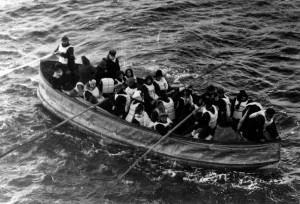 Whenever a big train wreck, plane crash, ship sinking, or other major accident occurs, someone must investigate. Depending on what happened, it can be someone like the NTSB, or in some cases, as in the Titanic sinking, it can go as high as the Senate. Of course, answers need to be found, so that corrections in procedure can be made.
Whenever a big train wreck, plane crash, ship sinking, or other major accident occurs, someone must investigate. Depending on what happened, it can be someone like the NTSB, or in some cases, as in the Titanic sinking, it can go as high as the Senate. Of course, answers need to be found, so that corrections in procedure can be made.
In the case of the Titanic, the accident was brought before the Senate Commerce Committee. I think most of us know the story of the Titanic well, given the movies and documentaries that have come out about it. The official final report, however, went into much more detail than most people know about, and more than I can go into here. I think most of us know that the ship was not sufficiently run through the test trials to properly break in the engines. Nevertheless, the Titanic was run at full speed through trecherous waters, without regard for the damage that could have come to pass.
In addition to this problem, it was noted that many of the crew members did not join the ship until just a few hours before it sailed, and the only drill carried out, consisted of lowering just two lifeboats on the starboard side into the water. There was no boat list designating the stations members of the crew were posted to until several days after sailing. This left the crew in ignorance of their stations until the following Friday morning. Of course, as we all know, there were not enough lifeboats on the ship, because it was thought to clutter the deck, and to be unnecessary. In reality there were only boats enough for only 1,176 of the 2,228 people on board…and of those, only 710 survived, meaning that lifeboats were lowered only partially loaded. Had the Titanic been loaded to full capacity, which was 3,339 passengers and crew, there would have only been room for a third of the people on the lifeboats. and as was the case of only loading the lifeboats half full, 2,629 people would have died.
It was the conclusion of the Senate Commerce Committee, that there were several areas of gross negligence 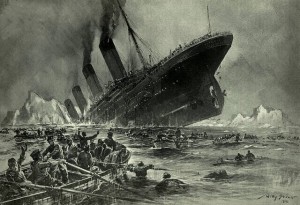 on the part of White Star Line and the crew of the Titanic. In fact the committee was actually appalled, as it should have been. They called the Titanic, and unnecessary tragedy. Improperly trained crew and improper procedures, can be a deadly mix, and as was the case with Titanic, death is what ensued. Many laws have changed as a result of the hearings, but I have to wonder why it takes such a devastating accident to bring about a proper, concervative apporoach to the handling of many areas of transportation, construction, and work ethic. To me, it seems a little late to try to put proper safety methods in place when the ship has already sunk, but then I guess it does protect those who will come after.
on the part of White Star Line and the crew of the Titanic. In fact the committee was actually appalled, as it should have been. They called the Titanic, and unnecessary tragedy. Improperly trained crew and improper procedures, can be a deadly mix, and as was the case with Titanic, death is what ensued. Many laws have changed as a result of the hearings, but I have to wonder why it takes such a devastating accident to bring about a proper, concervative apporoach to the handling of many areas of transportation, construction, and work ethic. To me, it seems a little late to try to put proper safety methods in place when the ship has already sunk, but then I guess it does protect those who will come after.

